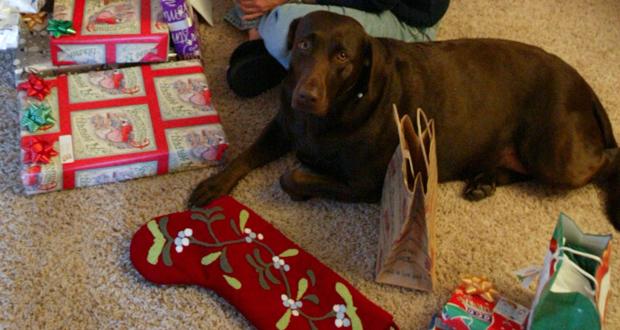Oceanside CA— The holiday season is here. This is the time to gather friends and family, break out the ornaments and whip up delicious meals. We all have our own routine for the season, but what about for our pets? From environmental dangers to food concerns, the holidays can bring about a whole new world of worry for pet owners. Here are a few tips to make sure your pet stays safe during the holidays.
One of the best parts of the season is brightening up homes with strands of colorful lights. While these lights are often admired by humans, they can present a serious danger to pets. If there’s one thing animals love, it’s chewing, and these electric cords often look like the perfect chew toy. Batteries used in lighting displays and toys under the tree can cause serious burns to an animal’s mouth and throat if punctured by their teeth, and often require surgery for removal if swallowed. To prevent your pet from getting into decorative lighting, keep wires, cords and batteries neatly tucked away and out of an animal’s reach.
Festive plants, such as mistletoe, holly and poinsettia, are often a must when outfitting a home for the holidays – but did you know these plants can prove fatal to pets? Instead of using real plants that are poisonous, try sprucing up your home with artificial ones. Similarly, potpourri and scented wax burners can also prove dangerous when ingested by animals, so these accents should also be kept in a discreet location. Station menorahs, candles and other flammable objects on a stable surface as animals can knock them over, creating a serious fire hazard.
A common holiday centerpiece is the Christmas tree – a decoration that is exceptionally tempting for pets. Cats and rabbits are especially attracted to shiny tinsel and glass ornaments. Cats tend to bat around glass ornaments that can shatter into razor sharp fragments, and Mylar tinsel can cause serious harm when swallowed. To prevent pets from injuring themselves on ornaments or toppling over the Christmas tree, try building a foil tree skirt that extends at least a foot beyond the tree’s circumference. Most pets will avoid the tree skirt’s crinkly surface.
In addition to environmental factors, one of the holiday’s key elements can cause serious problems for pets – food! The holidays often revolve around plates of food that are rich in fat and sugar. Humans have few problems digesting these ingredients, but scraps that are too rich in fat can cause health issues like pancreatitis in animals. Chocolate, artificial sweeteners like xylitol, uncooked dough and grapes and raisins can lead to life-threatening problems if eaten by pets. Make sure pets stay out of the kitchen and keep an eye on table scraps that could lead to illness.
Kahoots Feed and Pet representative Alicia Towkaniuk offered some insight into pet safety during the holidays: “Make preparing your pets for the holidays as much a part of your holiday routine as wrapping gifts or decorating the tree. Talk with everyone in the household about keeping dangerous items and foods out of reach. Post the numbers for your regular vet, a 24-hour emergency vet and the ASPCA Poison Control Hotline (888-426-4438) where they will be easy to find!”
The holidays should be a time of celebration, not veterinarian visits. Keep your pets safe by staying on top of these potential hazards.
Keep Your Pet Safe During the Holidays
December 14, 2016




